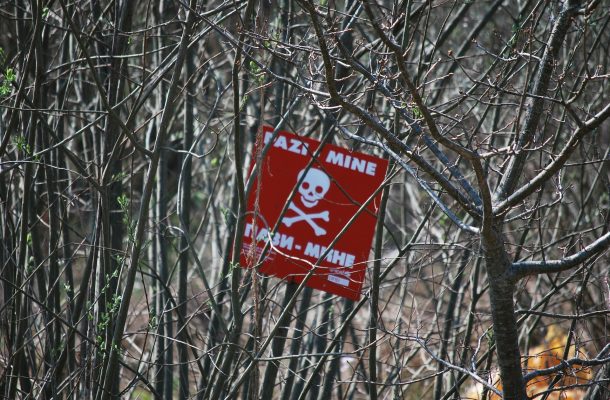Culture and challenge in the corporate world

When I was deployed to Bosnia as part of a NATO peacekeeping mission, minefields were something we came across fairly regularly. They were marked in a range of ways – some had the fairly obvious skull and crossbones on a red triangle and even if you couldn’t read the Cyrillic underneath, it didn’t take much imagination to work out that if you were on the side of the sign without writing then your day had taken a turn very much for the worse.
Other marking systems were, putting it mildly, less formal – a soft drink or beer can upturned on a stick could either be an interesting piece of installation art or a sign that you needed to be anywhere else but here. Regardless of the marking system, however, there was usually a cleared lane through them – or at least you could assume that if the tyre tracks went all the way through then it was clear, or had been at the time. And so where one brave soul has gone, and survived, another will follow, and another.
Believe me when I say it’s not an environment where experimentation or deviation from the proven path offers much appeal or benefit and so you just follow the tracks that have built up over time.
And it’s the same with team culture.
Culture coalesces around a challenge
There are many definitions of what culture is but I think it’s best described as what we do around here to achieve whatever we perceive as success. When we’ve seen what works, and what happens when we deviate from that formula, we have a strong incentive to stick with it.
In his book Tribal Leadership, Dave Logan suggests that team cultures exist at one of five levels and I reckon that the defining feature of each level is the nature, and location, of the challenge that they encounter on a regular basis and have learnt, through trial and error, to get through without things blowing up in their faces – much like a minefield.
At Level 1, the theme is that ‘life sucks’. The challenge is everywhereand so getting your retaliation in first is critical.
At Level 2, the language patterns suggest that ‘MY life sucks – because of …’. The challenge at this level is above them – in the form of an authority figure, such as the stereotypical ‘Boss from Hell’ and life is a rat race,
People at Level 3 have learnt to do what it takes to win at the rat race – they think that ‘I’m great, but YOU suck’. Here, the challenge is beside them and talented colleagues are seen as a threat.
Level 4 people have realised that they’ll get further, faster by collaborating – they’re thinking something like ’WE’RE great but THEY suck’. Their challenge is outside of them and they tend to place the needs of the team ahead of themselves.
Level 5 takes it to a whole new level. Here, ‘life is great’. Their goal is something that achieving it will, in some way, change the world for the better and they’ve realised that the only real challenges lie within them in the form of their own limiting beliefs.
Protecting the Crown Jewels
When a free kick is awarded in a game of soccer, the opposing team may elect to form a defensive wall by placing their bodies between the kicker and their own goal – a more extreme case of taking one for the team perhaps.
Standing 10 yards (9.1 metres in new money) away from the ball when it’s kicked, most players in the wall (and I’m talking here about the mens game for reasons that will become obvious) choose to place a hand over their groin area for the simple reason that they’d prefer not to get hit in the nuts by a ball weighing a little under half a kilogram moving at over 100 km/h.
In other words, they protect the most what they ultimately value the most – their crown jewels, if you like. In fact, I’ve often wondered why they don’t just turn around and face the other way but that’s another topic all together. It’s an instinctive reaction that can be observed throughout life – our behaviour is shaped by a combination of pleasure seeking and pain avoidance which ultimately manifests itself as what we call culture.
I think that instinctively we’re wired to prioritise avoidance of pain over seeking of pleasure. Waking up with a headache, for example, will see most people groping around immediately for a packed of paracetamol but missing a day, or even a week, of vitamin supplements probably wouldn’t bother most people too much. Both motivators – pleasure and pain – are important but I suggest that by looking at what we work hardest to protect ourselves against (pain), we can get a useful insight into a group culture.
What’s your poison?
Every culture has a particular insult that cuts deeper than any other. I’m not talking about plain old profanity – I’m talking about the word that, when it’s used to describe that person and their very essence or character, causes a visceral reaction.
What is it in your world?
Level 1 cultures hate anyone who even thinks they’re better than everyone else and so here it’s anything that suggests that someone is trying to break away from them.
In Level 2 cultures, authority is the enemy and so for them it’s implying that someone is attempting to gain favour with the authority figure or, even worse, become one of them.
Level 3 cultures regard success as being clearly perceived as better than everyone else and so they hate even the suggestion of incompetence of any kind.
At Level 4 it’s all about being a team player and the worst thing for them is to be accused of putting themselves before the team.
Level 5 is about realising our full potential as a human being and so here, it’s anything that implies that we’re playing small.
Where are you and your team playing?
This article was published by the Corporate Commando.
Adam O’Donnell employs insights from his military service to help Australian firms build elite teams to navigate volatile business environments. Apply lessons learned on the battlefield to your boardroom at Corporate Commando.








